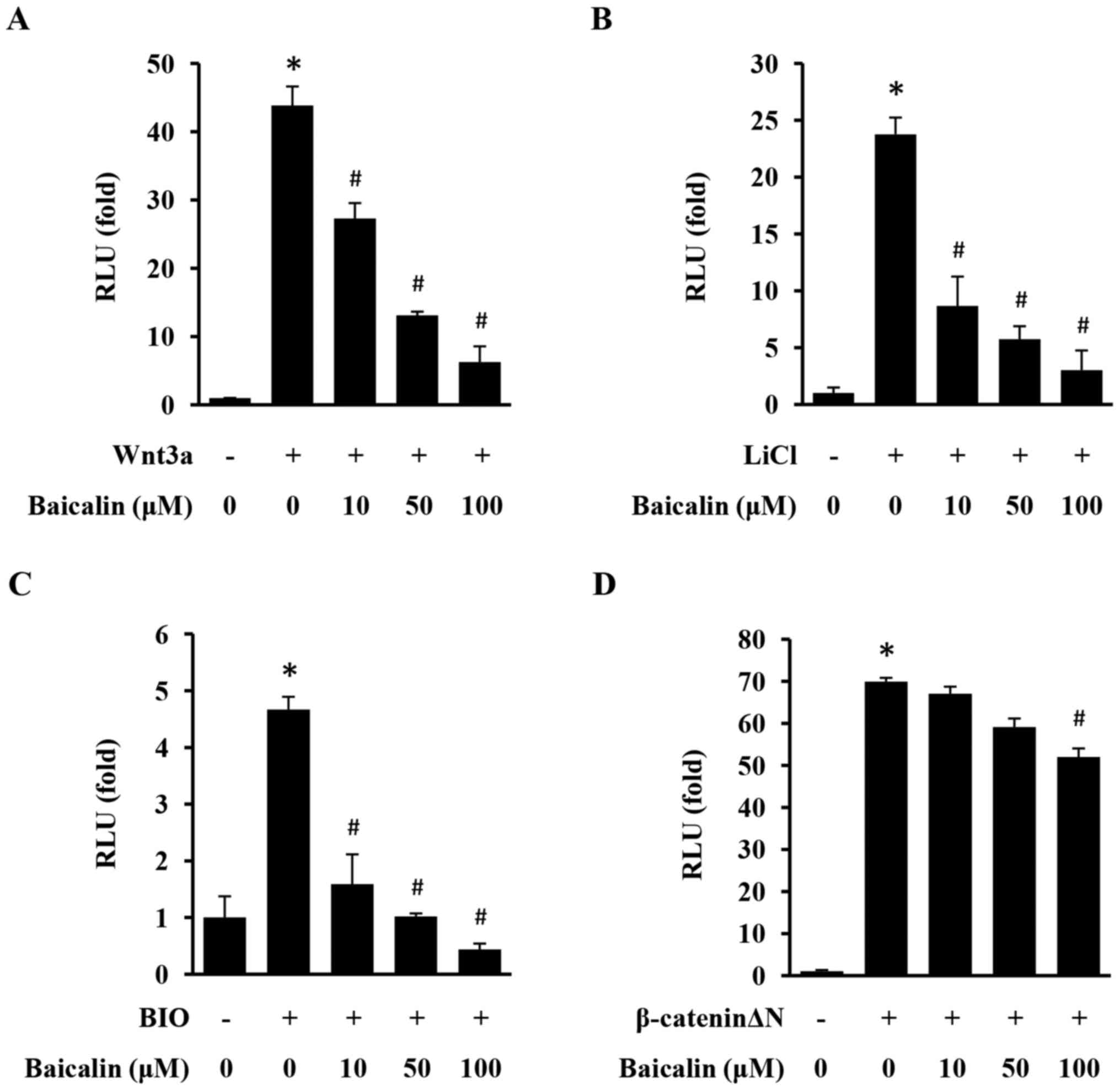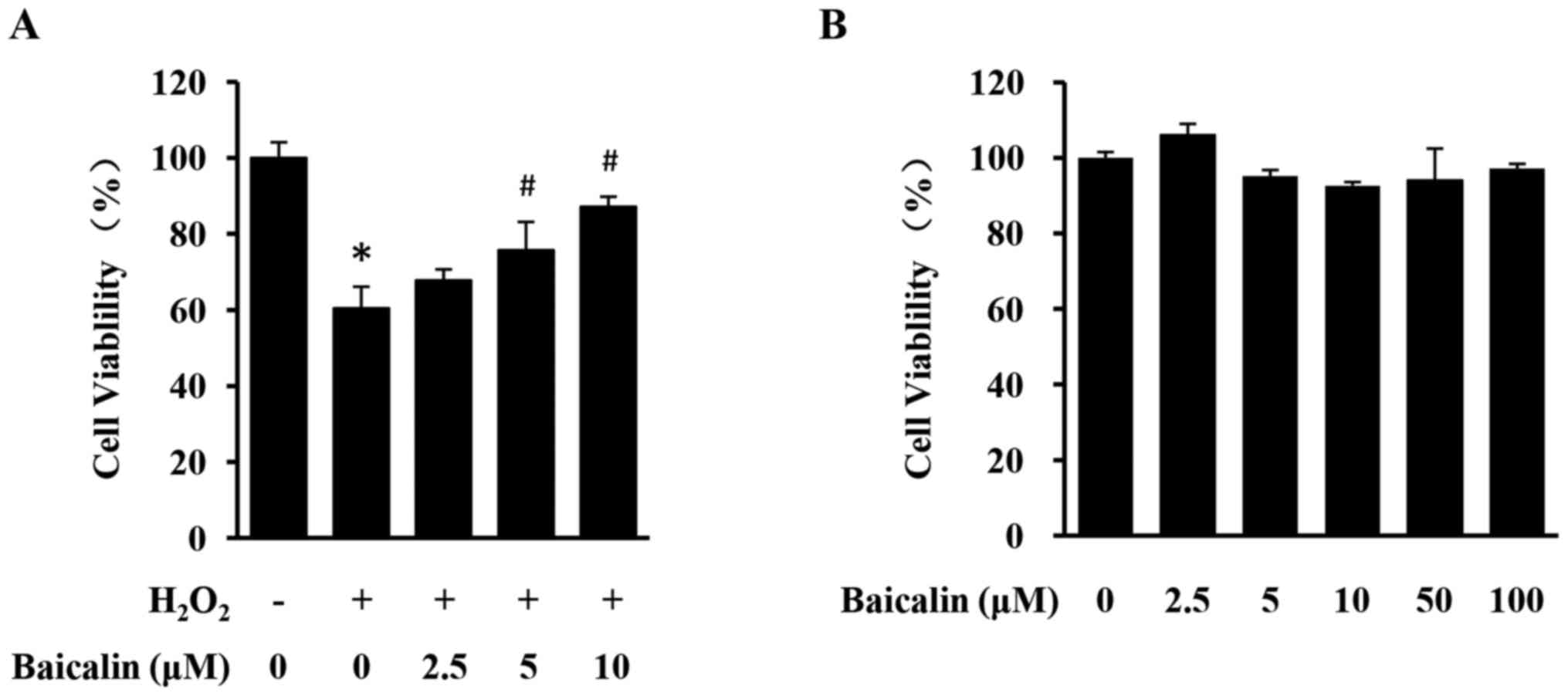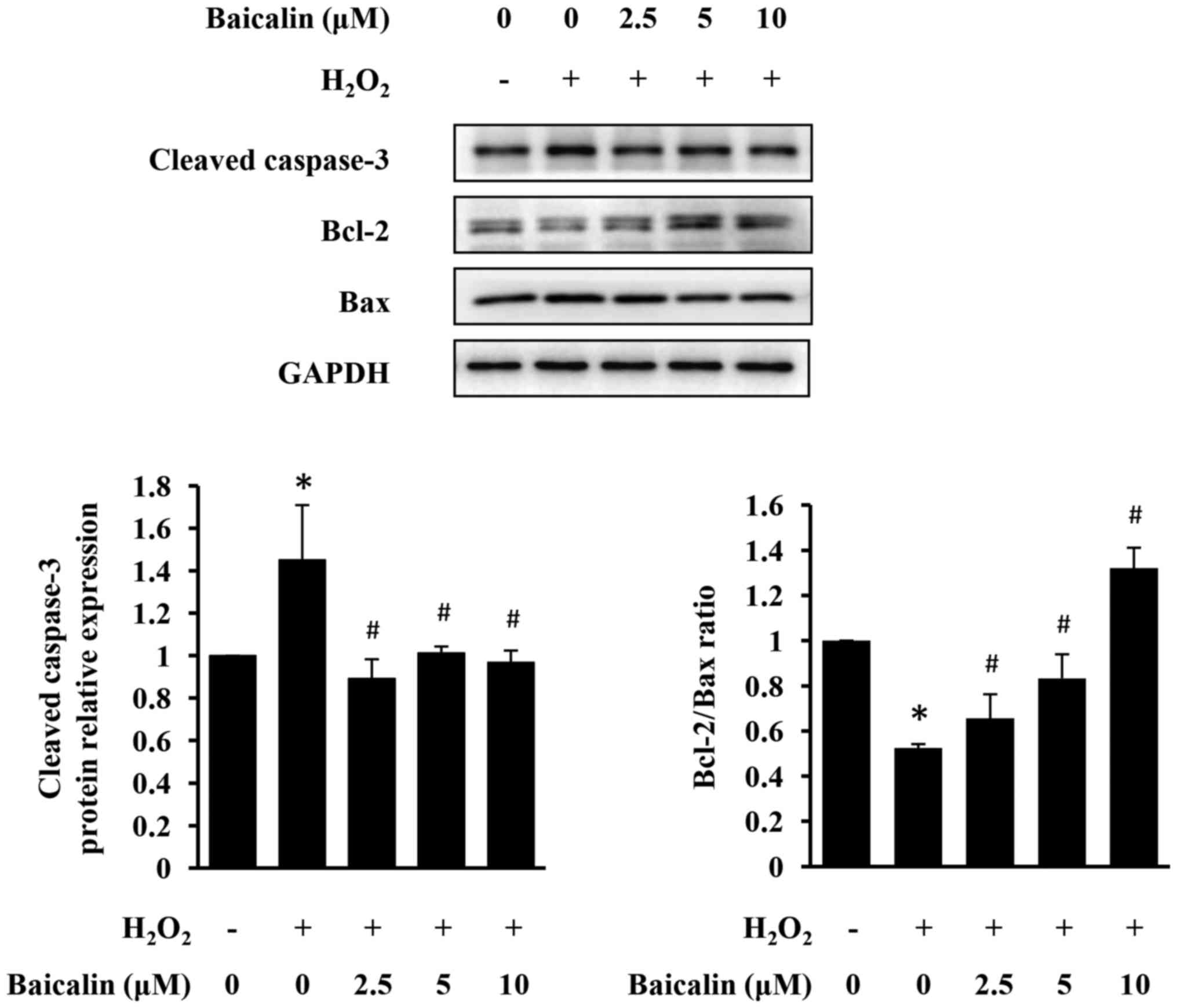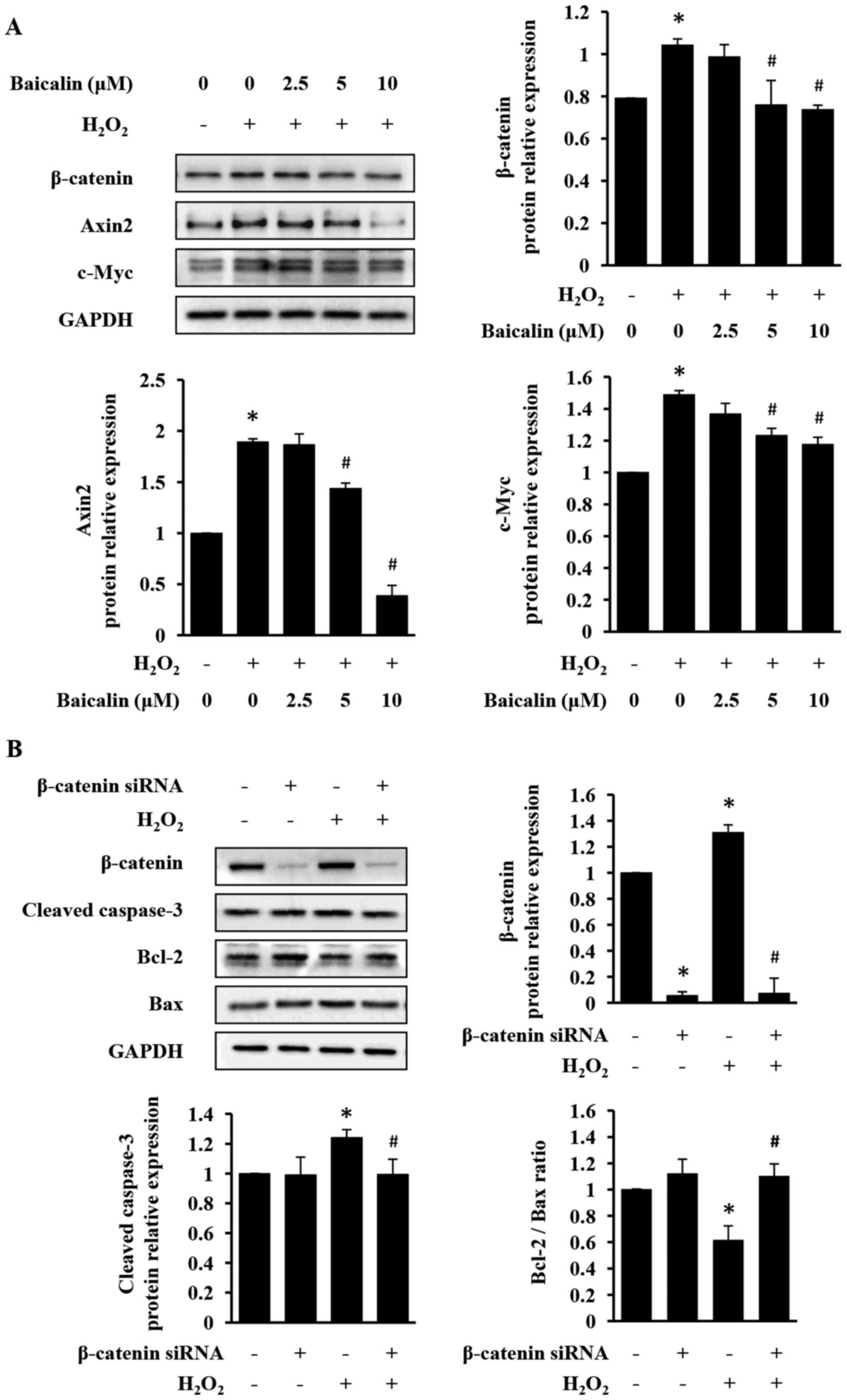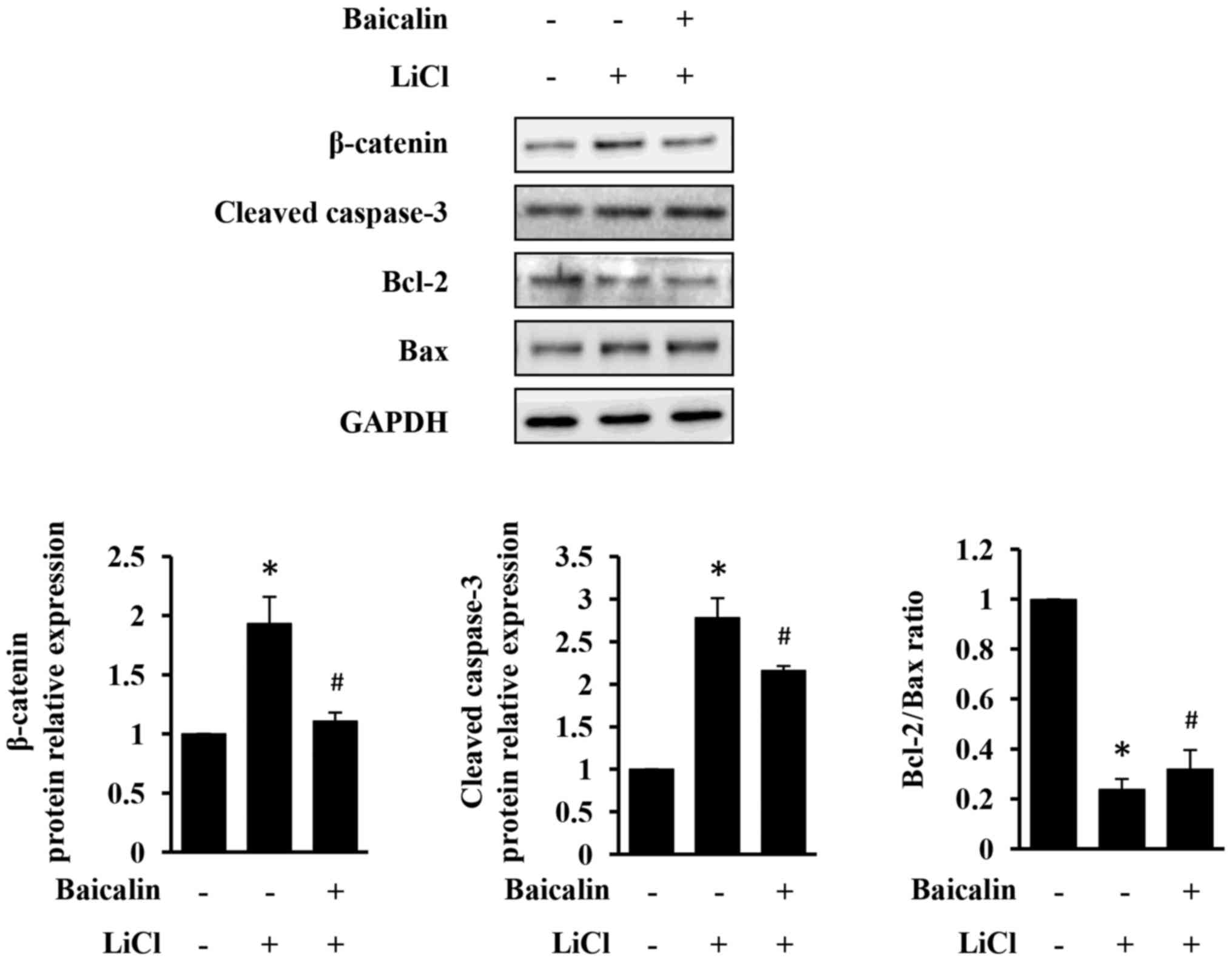Baicalin alleviates H2O2‑induced injury of H9c2 cardiomyocytes through suppression of the Wnt/β‑catenin signaling pathway
- Authors:
- Published online on: October 10, 2017 https://doi.org/10.3892/mmr.2017.7748
- Pages: 9251-9255
Abstract
Introduction
Proto-oncogene Wnt-1 (Wnt)/β-catenin signaling is associated with many developmental and physiological processes during early stages of embryonic development (1–4). The deregulation of Wnt signaling often leads to abnormalities, including heart disease (5–8). In the absence of the Wnt ligand, intracellular β-catenin is constantly degraded by the adenomatous polyposis coli (APC)/Axin/glycogensynthase kinase-3β (GSK-3β) complex. However, once Wnt ligand binds to the membrane receptors Frizzled and low density lipoprotein receptor related protein 5/6 (LRP5/6), it leads to the activation of Dishevelled (Dvl), resulting in the suppression of the APC/Axin/GSK-3β complex and activation of nuclear β-catenin, and associated downstream genes, including Axin2 and myc proto-oncogene protein (c-Myc) (9–11).
Baicalin (5,6-dihydroxyflavone-7-O-D-glucuronic) is an active ingredient extracted from dried roots of Scutellaria baicalensis Georgi. Baicalin has been used for the clinical treatment of certain acute and chronic inflammatory diseases. Baicalin attenuates oxidative damage and apoptosis of myocardial cells and protects against myocardial ischemia reperfusion injury (12,13). Previous in vivo studies suggested that cardioprotection mediated by baicalin was associated with the modulation of the mitogen-activated protein kinase 1 pathway (14,15). Baicalin may decrease the activity of the sympathetic nervous system by inhibiting the P2X3 receptor in rat superior cervical ganglia to protect the myocardium from the ischemic injury (16). Another study demonstrated that baicalin can protect cardiomyocytes from endoplasmic reticulum stress-induced apoptosis via the DNA-damage-inducible transcript/CCAAT/enhancer-binding protein/endothelia nitric oxide synthase/nitric oxide pathway (17). However, the Wnt/β-catenin signaling pathway-mediated molecular mechanism underlying the cardioprotective effect of baicalin remains to be elucidated.
Since the concentration of reactive oxygen species (ROS) is elevated in cardiac injury, including ischemic heart disease (IHD), H2O2-treated cardiomyocyte cell lines have commonly been used as an in vitro model of cardiac injury to study the cardioprotective effects of drugs against oxidative damage (18–23). Therefore, in the present study, H2O2-treated H9c2 cells were used to evaluate the effects of baicalin on cardiac injury and on the activation of Wnt/β-catenin signal pathway.
Materials and methods
Cell culture, transfection and treatment
Cells were cultured in Dulbecco's modified Eagle's medium (DMEM; Wisent Inc., St Bruno, QC, Canada) supplemented with 10% fetal bovine serum (Biological Industries, Kibbutz Beit Haemek, Israel), 100 U/ml penicillin and 100 mg/ml streptomycin (both, purchased from Gibco; Thermo Fisher Scientific, Inc., Waltham, MA, USA) and cultured in a 37°C humidified incubator supplemented with 5% CO2. For the transfection assay, cells were plated at 1.0×105 cells/well and were transfected with small interfering (si)RNA of β-catenin (Invitrogen; Thermo Fisher Scientific, Inc.) or Stealth RNAi® negative control duplexes (NC) (cat. no. 12935300, Invitrogen; Thermo Fisher Scientific, Inc.) for 48 h using Lipofectamine 2000 transfection reagent (Invitrogen; Thermo Fisher Scientific, Inc.). The following β-catenin siRNA oligo sequences were used: 5′-UGUAGCAGGAGAUUAUGCAGCGUGG-3′ (forward) and 5′-CCACGCUGCAUAAUCUCCUGCUACA-3′ (reverse). H9c2 cells were stimulated with 200 µM H2O2 for 2 h prior to an MTT assay and with 100 µM H2O2 for 30 min prior to the western blotting assay, to establish the myocardial oxidative damage model. 293T cells were co-transfected with 1 ng/well V5-tagged Wnt3a (Wnt3a), 30 mM LiCl, 0.5 µM BIO or 40 ng/well β-cateninΔN (β-catenin truncation mutant with N-terminal region deletion), as well as TOPFlash for 48 h before detecting RLU (relative light units) values in each experimental group. Negative control group was transfected with TOPFlash only and positive control group was transfected with wnt3a or activator of Wnt/β-catenin signaling pathway (LiCl, BIO or β-cateninΔN), as well as TOPFlash but not treated with baicalin. Wnt3a was provided by X. He and C. Niehrs (German Cancer Research Center) (24–27). TOPFlash reporters were provided by RT. Moon (University of Washington, School of Medicine) (28). LiCl, BIO and NaCl were purchased from Sigma-Aldrich; Merck KGaA, Darmstadt, Germany. Baicalin was purchased from Chengdu Must Bio-Technology Co., Ltd.; Chengdu, Sichuan, China.
Reporter gene assay
A TOPFlash/Renilla reporter gene assay was performed as previously described (24,29). Cells were seeded in 96-well plates at 4×103 cells/well and transfected with 40 ng TOPFlash plasmids for Wnt and β-catenin and 10 ng Renilla luciferase control reporter vector. A total of 48 h following transfection, cells were lysed with cell lysis buffer (50 mM Tris-HCl pH 7.4, 150 mM NaCl, 1% nadeoxycholale, 0.5 M EDTA, 1% Nonidet 40, 5 mM DTT, 10 µg aprotinin, 10 µg leupeptin, 10 mM PMSF) and screened for luciferase activity using the Dual-Luciferase Reporter Assay system according to the manufacturer's protocol (Promega Corporation, Madison, WI, USA).
Cell isolation and protein extraction
For total cellular protein extraction, cells were lysed with a lysis buffer (50 mM Tris-HCl pH 7.4, 150 mM NaCl, 1% nadeoxycholale, 0.5 M EDTA, 1% Nonidet 40, 5 mM DTT, 10 µg aprotinin, 10 µg leupeptin, 10 mM PMSF) on ice for 15 min and centrifuged at 4,000 × g for 15 min at 4°C, prior to the collection of the supernatant. Nuclear extracts were prepared as follows: Cells were resuspended in 400 µl hypotonic buffer (20 mM Tris-HCl pH 7.4, 10 mM NaCl, 3 mM MgCl2; 10% Nonidet; 5 M DTT; 10 µg Aprotinin; 10 µg Leupeptin; 10 mM PMSF) and incubated on ice for 10 min, then centrifuged at 1,000 × g for 5 min at 4°C. Following separation, the pellet was re-suspended in the lysis buffer on ice for 20 min. Following centrifugation at 4,000 × g for 10 min at 4°C, the supernatant (nuclear extract) was collected.
Western blotting
Concentrations of proteins were quantified using the bicinchoninic acid method. Subsequently, 30 µg proteins per lane were subjected in 10% sodium dodecyl polyacrylamide gel (Sangon Biotech Co., Ltd., Shanghai, China) using 1× SDS-PAGE running buffer (cat. no. P0014; Beyotime Institute of Biotechnology, Haimen, China), and then transferred onto a polyvinylidene fluoride membrane (EMD Millipore, Billerica, MA, USA) using 1× western transfer buffer (cat. no. P0021A; Beyotime Institute of Biotechnology). Following blocking with 5% skimmed dry milk in TBS (20 mM Tris-HCl pH 7.4, 150 mM NaCl) with 0.1% Tween 20 (TBST) for 1 h at room temperature, membranes were incubated with the following polyclonal primary antibodies: Rabbit anti-Axin-2 (1:5,000; cat. no. ab32197; Abcam, Cambridge, UK), mouse anti-c-Myc (1:5,000; cat. no. ab32, Abcam), rabbit anti-β-catenin (1:1,000; cat. no. 8480; Cell Signaling Technology, Inc., Danvers, MA, USA), rabbit anti-apoptosis regulator Bcl-2 (Bcl-2) (1:1,000; cat. no. 2870; Cell Signaling Technology, Inc.), rabbit anti-apoptosis regulator BAX (Bax) (1:1,000; cat. no. 2772; Cell Signaling Technology, Inc.), rabbit anti-cleaved caspase-3 (1:1,000; cat. no. 9664; Cell Signaling Technology, Inc.) and mouse anti-GAPDH (1:1,000; cat. no. 60004-1-Ig; ProteinTech Group, Inc., Chicago, IL, USA) at 4°C overnight. The membranes were subsequently washed with TBST and incubated with horseradish peroxidase-conjugated goat anti-rabbit IgG secondary antibody (1:25,000; cat. no. 31460; Thermo Fisher Scientific, Inc.) or rabbit anti-mouse IgG secondary antibody (1:25,000; cat. no. 27025; Thermo Fisher Scientific Inc.) at room temperature for 1 h. Following washing by TBST, the membranes were placed in enhanced chemifluorescence solution (EMD Millipore) for 1 min. Immunoreactive bands were visualized by an Image Quant LAS 500 Imager (GE Healthcare Life Sciences, Shanghai, China), and the densitometry of bands were calculated by Quantity One software (version 4.62; Bio-Rad laboratories Inc., Hercules, CA, USA).
MTT assay
H9c2 cells were seeded in 96-well plates at a density of 4×103 cells/well. MTT (0.5 mg/ml; Beyotime Institute of Biotechnology) was added and cells were incubated for 4 h at 37°C prior to the addition of dimethyl sulfoxide. The absorbance was measured at a wavelength of 490 nm according to the manufacturer's protocol (SpectraMax® M2/M2e Multiskan; Molecular Devices LLC, Sunnyvale, CA, USA). All experiments were performed in quintuplicate.
Statistical analysis
All data are expressed as the mean ± standard deviation. All statistical analyses were performed using SPSS software (version 20.0; IBM Corp., Armonk, NY, USA). Statistical significance was concluded by one-way analysis of variance, followed by the Fisher post hoc test for multiple comparisons and unpaired t-test for between two groups comparisons. All experiments were replicated at least three times. P<0.05 was considered to indicate a statistically significant difference.
Results
Baicalin inhibits the activation of the Wnt/β-catenin pathway in 293 cells
The TOPFlash/Renilla reporter gene assay was used to evaluate the effect of baicalin on the activation of the Wnt/β-catenin pathway in 293 cells. As presented in Fig. 1, Wnt/β-catenin signaling was significantly activated upon stimulation with Wnt3a, LiCl, BIO and β-cateninΔN. However, baicalin induced a specific and significant inhibitory effect on the activation of TOPFlash with in a dose-dependent manner, demonstrating that baicalin efficiently inhibits the Wnt/β-catenin signaling pathway.
Baicalin protects against H2O2-induced loss of H9c2 cell viability
To evaluate the cardioprotective effects of baicalin against H2O2-induced cardiotoxicity, H2O2-stimulated H9c2 cells were treated with different concentrations of baicalin and cell viability was assessed using an MTT assay. Stimulation with H2O2 led to a significant decrease in H9c2 cell viability, which was significantly reversed by the treatment with baicalin in a dose-dependent manner (Fig. 2A). Treatment with baicalin alone exhibited no effect on the viability of H9c2 cells even at increased concentrations (Fig. 2B). Therefore, baicalin can protect against oxidative damage of cardiomyocytes in vitro, without causing apparent cytotoxicity.
Baicalin prevents H2O2-induced apoptosis of H9c2 cells
The effect of baicalin on H2O2-induced apoptosis of H9c2 cells was examined using western blot analysis. As presented in Fig. 3, H2O2 upregulated the expression of cleaved caspase-3 and increased the pro-apoptotic Bax/Bcl-2 ratio in H9c2 cells, indicating pro-apoptotic property of H2O2. However, baicalin significantly inhibited H2O2-induced cardiomyocyte apoptosis, in a dose-dependent manner (Fig. 3).
Baicalin inhibits apoptosis by suppressing β-catenin expression in H9c2 cells
To investigate the mechanism underlying the anti-apoptotic and cardioprotective activities of baicalin, its effect on the expression levels of β-catenin and its downstream targets axin-2 and c-Myc in H9c2 cells was determined. As presented in Fig. 4A, baicalin treatment significantly suppressed H2O2-induced expression of β-catenin, axin-2 and c-Myc. Additionally, siRNA-mediated downregulation of β-catenin expression prevented apoptosis in H2O2-treated H9c2 cells (Fig. 4B). LiCl, a GSK-3β inhibitor, commonly used to stabilize β-catenin, was used to further verify above-observed results (30–32). As presented in Fig. 5, LiCl increased β-catenin expression, which in turn induced apoptosis of H9c2 cells. However, LiCl-induced injury in H9c2 cells was significantly neutralized by the treatment with baicalin (Fig. 5). Taken together, the results of the present study indicate that baicalin exerts an anti-apoptotic activity, likely through the suppression of the Wnt/β-catenin pathway.
Discussion
The present study demonstrated that baicalin attenuated H2O2-induced H9c2 cell injury through inhibition of the Wnt/β-catenin signaling pathway. It was demonstrated that β-catenin serves a crucial role in enhancing H2O2-induced injury of H9c2 cells, which is attenuated by pretreatment with baicalin. Previous studies have demonstrated that ROS can modulate the Wnt/β-catenin signaling pathway via regulation of the redox-dependent interaction between Dvl and nucleoredoxin (NRX). NRX normally interacts with Dvl and inhibits activation of the Wnt/β-catenin pathway. However, under oxidative stress, NRX dissociates from Dvl and enables Dvl to activate Wnt/β-catenin signaling (33). An association between Dvl and NRX supports the results of the present study, and suggests that ROS can promote the activation of Wnt/β-catenin signaling, suggesting that baicalin can potentially regulate the expression of Dvl/NRX.
The present study indicates that the suppression of Wnt/β-catenin signaling pathway can be a potential strategy for the treatment of IHD. It has been previously demonstrated that insulin-like growth factor binding protein 4 is a robust inhibitor of Wnt/β-catenin signaling, which can effectively protect the heart from the ischemic injury (8,34), which further supports the results of the present study. Baicalin is commonly used in the clinical treatment of various diseases. Whether baicalin can be applied for the treatment of IHD remains to be elucidated.
In conclusion, the present study is, to the best of the authors' knowledge, the first one to demonstrate the role of baicalin in the modulation of Wnt/β-catenin signaling pathway. Baicalin suppresses the activation of Wnt/β-catenin signaling pathway via regulation of β-catenin, leading to the protection against H2O2-induced apoptosis of H9c2 cells. The present study provides novel insights and theoretical basis for the potential use of baicalin in the treatment of IHD.
Acknowledgements
The present study was supported by the National Natural Science Foundation of China (grant no. 81302884) and the Developmental Fund of Chen Keji Integrative Medicine (grants no. CKJ 2016005, 2016003 and 2016002).
Glossary
Abbreviations
Abbreviations:
|
APC |
adenomatous polyposis coli |
|
GSK-3β |
glycogensynthase kinase-3β |
|
LRP5/6 |
low-density lipoprotein receptor-related protein 5/6 |
|
Dvl |
Dishevelled |
|
NRX |
nucleoredoxin |
|
ROS |
reactive oxygen species |
|
IHD |
ischemic heart disease |
References
|
Dohn TE and Waxman JS: Distinct phases of Wnt/β-catenin signaling direct cardiomyocyte formation in zebrafish. Dev Biol. 361:364–376. 2012. View Article : Google Scholar : PubMed/NCBI | |
|
Gessert S and Kühl M: The multiple phases and faces of wnt signaling during cardiac differentiation and development. Circ Res. 107:186–199. 2010. View Article : Google Scholar : PubMed/NCBI | |
|
Gibb N, Lavery DL and Hoppler S: Sfrp1 promotes cardiomyocyte differentiation in Xenopus via negative-feedback regulation of Wnt signalling. Development. 140:1537–1549. 2013. View Article : Google Scholar : PubMed/NCBI | |
|
Yamashita JK, Takano M, Hiraoka-Kanie M, Shimazu C, Peishi Y, Yanagi K, Nakano A, Inoue E, Kita F and Nishikawa S: Prospective identification of cardiac progenitors by a novel single cell-based cardiomyocyte induction. FASEB J. 19:1534–1536. 2005.PubMed/NCBI | |
|
Barandon L, Couffinhal T, Ezan J, Dufourcq P, Costet P, Alzieu P, Leroux L, Moreau C, Dare D and Duplàa C: Reduction of infarct size and prevention of cardiac rupture in transgenic mice overexpressing FrzA. Circulation. 108:2282–2289. 2003. View Article : Google Scholar : PubMed/NCBI | |
|
Mirotsou M, Zhang Z, Deb A, Zhang L, Gnecchi M, Noiseux N, Mu H, Pachori A and Dzau V: Secreted frizzled related protein 2 (Sfrp2) is the key Akt-mesenchymal stem cell-released paracrine factor mediating myocardial survival and repair. Proc Natl Acad Sci USA. 104:pp. 1643–1648. 2007; View Article : Google Scholar : PubMed/NCBI | |
|
Zhang Z, Deb A, Zhang Z, Pachori A, He W, Guo J, Pratt R and Dzau VJ: Secreted frizzled related protein 2 protects cells from apoptosis by blocking the effect of canonical Wnt3a. J Mol Cell Cardiol. 46:370–377. 2009. View Article : Google Scholar : PubMed/NCBI | |
|
Zhu W, Shiojima I, Ito Y, Li Z, Ikeda H, Yoshida M, Naito AT, Nishi J, Ueno H, Umezawa A, et al: IGFBP-4 is an inhibitor of canonical Wnt signalling required for cardiogenesis. Nature. 454:345–349. 2008. View Article : Google Scholar : PubMed/NCBI | |
|
Funato Y and Miki H: Redox regulation of Wnt signalling via nucleoredoxin. Free Radic Res. 44:379–388. 2010. View Article : Google Scholar : PubMed/NCBI | |
|
Kafka A, Bašić-Kinda S and Pećina-Šlaus N: The cellular story of dishevelleds. Croat Med J. 55:459–467. 2014. View Article : Google Scholar : PubMed/NCBI | |
|
MacDonald BT, Tamai K and He X: Wnt/beta-catenin signaling: Components, mechanisms, and diseases. Dev Cell. 17:9–26. 2009. View Article : Google Scholar : PubMed/NCBI | |
|
Kong F, Luan Y, Zhang ZH, Cheng GH, Qi TG and Sun C: Baicalin protects the myocardium from reperfusion-induced damage in isolated rat hearts via the antioxidant and paracrine effect. Exp Ther Med. 7:254–259. 2014. View Article : Google Scholar : PubMed/NCBI | |
|
Xu M, Chen X, Gu Y, Peng T, Yang D, Chang RC, So KF, Liu K and Shen J: Baicalin can scavenge peroxynitrite and ameliorate endogenous peroxynitrite-mediated neurotoxicity in cerebral ischemia-reperfusion injury. J Ethnopharmacol. 150:116–124. 2013. View Article : Google Scholar : PubMed/NCBI | |
|
Liu X, Gu J, Fan Y, Shi H and Jiang M: Baicalin attenuates acute myocardial infarction of rats via mediating the mitogen-activated protein kinase pathway. Biol Pharm Bull. 36:988–994. 2013. View Article : Google Scholar : PubMed/NCBI | |
|
Sun SJ, Wu XP, Song HL and Li GQ: Baicalin ameliorates isoproterenol-induced acute myocardial infarction through iNOS, inflammation, oxidative stress and P38MAPK pathway in rat. Int J Clin Exp Med. 8:22063–22072. 2015.PubMed/NCBI | |
|
Zhang J, Liu S, Xu B, Li G, Li G, Huang A, Wu B, Peng L, Song M, Xie Q, et al: Study of baicalin on sympathoexcitation induced by myocardial ischemia via P2X3 receptor in superior cervical ganglia. Auton Neurosci. 189:8–15. 2015. View Article : Google Scholar : PubMed/NCBI | |
|
Shen M, Wang L, Yang G, Gao L, Wang B, Guo X, Zeng C, Xu Y, Shen L, Cheng K, et al: Baicalin protects the cardiomyocytes from ER stress-induced apoptosis: Inhibition of CHOP through induction of endothelial nitric oxide synthase. PLoS One. 9:e883892014. View Article : Google Scholar : PubMed/NCBI | |
|
Berg K, Jynge P, Bjerve K, Skarra S, Basu S and Wiseth R: Oxidative stress and inflammatory response during and following coronary interventions for acute myocardial infarction. Free Radic Res. 39:629–636. 2005. View Article : Google Scholar : PubMed/NCBI | |
|
Sun Y: Myocardial repair/remodelling following infarction: Roles of local factors. Cardiovasc Res. 81:482–490. 2009. View Article : Google Scholar : PubMed/NCBI | |
|
Diestel A, Drescher C, Miera O, Berger F and Schmitt KR: Hypothermia protects H9c2 cardiomyocytes from H2O2 induced apoptosis. Cryobiology. 62:53–61. 2011. View Article : Google Scholar : PubMed/NCBI | |
|
Eguchi M, Liu Y, Shin EJ and Sweeney G: Leptin protects H9c2 rat cardiomyocytes from H2O2-induced apoptosis. FEBS J. 275:3136–3144. 2008. View Article : Google Scholar : PubMed/NCBI | |
|
Law CH, Li JM, Chou HC, Chen YH and Chan HL: Hyaluronic acid-dependent protection in H9C2 cardiomyocytes: A cell model of heart ischemia-reperfusion injury and treatment. Toxicology. 303:54–71. 2013. View Article : Google Scholar : PubMed/NCBI | |
|
Park ES, Kang JC, Jang YC, Park JS, Jang SY, Kim DE, Kim B and Shin HS: Cardioprotective effects of rhamnetin in H9c2 cardiomyoblast cells under H2 O2 -induced apoptosis. J Ethnopharmacol. 153:552–560. 2014. View Article : Google Scholar : PubMed/NCBI | |
|
Chen J, Yan H, Ren DN, Yin Y, Li Z, He Q, Wo D, Ho MS, Chen Y, Liu Z, et al: LRP6 dimerization through its LDLR domain is required for robust canonical Wnt pathway activation. Cell Signal. 26:1068–1074. 2014. View Article : Google Scholar : PubMed/NCBI | |
|
Mao B, Wu W, Davidson G, Marhold J, Li M, Mechler BM, Delius H, Hoppe D, Stannek P, Walter C, et al: Kremen proteins are Dickkopf receptors that regulate Wnt/beta-catenin signalling. Nature. 417:664–667. 2002. View Article : Google Scholar : PubMed/NCBI | |
|
Mao B, Wu W, Li Y, Hoppe D, Stannek P, Glinka A and Niehrs C: LDL-receptor-related protein 6 is a receptor for Dickkopf proteins. Nature. 411:321–325. 2001. View Article : Google Scholar : PubMed/NCBI | |
|
Tamai K, Semenov M, Kato Y, Spokony R, Liu C, Katsuyama Y, Hess F, Saint-Jeannet JP and He X: LDL-receptor-related proteins in Wnt signal transduction. Nature. 407:530–535. 2000. View Article : Google Scholar : PubMed/NCBI | |
|
Veeman MT, Slusarski DC, Kaykas A, Louie SH and Moon RT: Zebrafish prickle, a modulator of noncanonical Wnt/Fz signaling, regulates gastrulation movements. Curr Biol. 13:680–685. 2003. View Article : Google Scholar : PubMed/NCBI | |
|
Ren DN, Chen J, Li Z, Yan H, Yin Y, Wo D, Zhang J, Ao L, Chen B, Ito TK, et al: LRP5/6 directly bind to Frizzled and prevent Frizzled-regulated tumour metastasis. Nat Commun. 6:69062015. View Article : Google Scholar : PubMed/NCBI | |
|
Caraci F, Gili E, Calafiore M, Failla M, La Rosa C, Crimi N, Sortino MA, Nicoletti F, Copani A and Vancheri C: TGF-beta1 targets the GSK-3beta/beta-catenin pathway via ERK activation in the transition of human lung fibroblasts into myofibroblasts. Pharmacol Res. 57:274–282. 2008. View Article : Google Scholar : PubMed/NCBI | |
|
Wang Y, Lam JB, Lam KS, Liu J, Lam MC, Hoo RL, Wu D, Cooper GJ and Xu A: Adiponectin modulates the glycogen synthase kinase-3beta/beta-catenin signaling pathway and attenuates mammary tumorigenesis of MDA-MB-231 cells in nude mice. Cancer Res. 66:11462–11470. 2006. View Article : Google Scholar : PubMed/NCBI | |
|
Zhang Y, Qiu WJ, Liu DX, Neo SY, He X and Lin SC: Differential molecular assemblies underlie the dual function of Axin in modulating the WNT and JNK pathways. J Biol Chem. 276:32152–32159. 2001. View Article : Google Scholar : PubMed/NCBI | |
|
Funato Y, Michiue T, Asashima M and Miki H: The thioredoxin-related redox-regulating protein nucleoredoxin inhibits Wnt-beta-catenin signalling through dishevelled. Nat Cell Biol. 8:501–508. 2006. View Article : Google Scholar : PubMed/NCBI | |
|
Wo D, Peng J, Ren DN, Qiu L, Chen J, Zhu Y, Yan Y, Yan H, Wu J, Ma E, et al: Opposing roles of Wnt inhibitors IGFBP-4 and Dkk1 in cardiac ischemia by differential targeting of LRP5/6 and β-catenin. Circulation. 134:1991–2007. 2016. View Article : Google Scholar : PubMed/NCBI |



